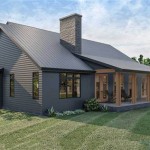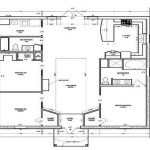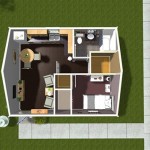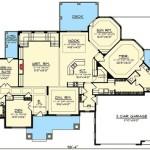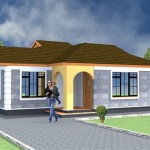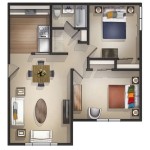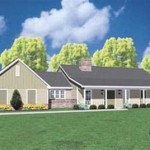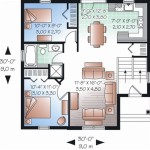Big Family House Floor Plans: Designing for Space and Functionality
Designing a house for a large family presents unique challenges and opportunities. Unlike homes intended for smaller households, these dwellings require careful consideration of spatial arrangements, traffic flow, privacy, and communal areas. Floor plans must accommodate a multitude of needs, balancing individual comfort with shared experiences. A successful large family home is more than just a collection of rooms; it is a carefully orchestrated environment that fosters both independence and togetherness.
The creation of an effective floor plan begins with a thorough understanding of the family's lifestyle. How do family members interact? What are their daily routines? Are there specific hobbies or activities that require dedicated spaces? Answers to these questions will inform the overall design and ensure that the finished product meets the family's specific requirements and aspirations. Failing to adequately plan at this stage can lead to a home that feels cramped, disorganized, or simply unsuitable for the needs of a large household.
Prioritizing Open-Concept Living
Open-concept floor plans are frequently favored in designs for large families. These designs typically combine the kitchen, dining area, and living room into one large, unified space. This arrangement fosters a sense of connection and allows family members to interact more easily, even when engaged in different activities. For parents, an open-concept layout can be particularly beneficial, allowing them to supervise children while preparing meals or completing other tasks.
However, open-concept living also presents potential challenges. Noise levels can be higher, and maintaining a sense of order can be more difficult. To mitigate these issues, designers often incorporate strategic zoning within the open space. This can be achieved through the use of furniture arrangements, area rugs, changes in flooring materials, or even subtle variations in ceiling height. These techniques help to visually define different areas within the larger space, creating a sense of separation without sacrificing the overall feeling of openness.
Furthermore, sound absorption should be a key consideration in open-concept designs. Hard surfaces, such as hardwood floors and drywall, tend to reflect sound, which can contribute to a noisy environment. Incorporating softer materials, such as upholstered furniture, curtains, and area rugs, can help to absorb sound and create a more comfortable and acoustically balanced space. The inclusion of sound-absorbing panels on walls or ceilings can further enhance noise reduction.
Finally, ample storage solutions are crucial in open-concept living areas. Clutter can quickly overwhelm an open space, so it is essential to incorporate built-in storage, such as shelving units, cabinets, and drawers. Multifunctional furniture, such as ottomans with hidden storage, can also be a valuable asset in maintaining a tidy and organized living environment.
Creating Dedicated Zones for Privacy and Relaxation
While communal spaces are essential for family interaction, it is equally important to provide individual zones where family members can retreat for privacy and relaxation. This is particularly crucial in large family homes, where the need for personal space can be heightened. These dedicated zones can take many forms, ranging from individual bedrooms to shared study areas or even quiet nooks tucked away in hallways or under staircases.
Bedroom design should consider the individual needs of each occupant. Younger children may benefit from shared bedrooms, which can foster a sense of camaraderie and provide opportunities for social interaction. However, older children and teenagers typically require their own private spaces, where they can study, relax, and pursue their individual interests. The size and layout of bedrooms should also be tailored to the age and needs of the occupant. For example, teenagers may require larger desks, more storage space, and dedicated areas for hobbies or personal projects.
In addition to bedrooms, consider incorporating other dedicated zones for relaxation and recreation. A home theater or media room can provide a space for family members to enjoy movies, television shows, and video games together. A library or reading room can offer a quiet retreat for those seeking solitude and intellectual stimulation. A finished basement can be transformed into a game room, hobby area, or even a home gym. The key is to create spaces that cater to the diverse interests and needs of the family members.
Soundproofing is an important consideration when designing these dedicated zones. Walls and doors should be adequately insulated to minimize noise transmission between rooms. The use of solid-core doors can significantly reduce sound leakage. Acoustic panels can also be installed on walls and ceilings to further enhance sound absorption.
Maximizing Functionality with Practical Design Elements
Effective floor plans for large families prioritize functionality and practicality. This involves incorporating design elements that streamline daily routines, maximize storage space, and make the home easier to maintain. A mudroom, for example, is an invaluable asset in a large family home. This transitional space provides a convenient place to store shoes, coats, backpacks, and other items, preventing clutter from accumulating in the main living areas. A well-designed mudroom should include ample storage, durable flooring, and a comfortable seating area for putting on and taking off shoes.
The kitchen is another area where functionality is paramount. In a large family home, the kitchen is often the heart of the household, and it needs to be designed to accommodate frequent use. This means incorporating ample counter space, efficient appliances, and plenty of storage. A large island can provide additional workspace and seating, while a walk-in pantry can help to keep food supplies organized and easily accessible. Consider incorporating multiple sinks and dishwashers to streamline meal preparation and cleanup.
Laundry rooms should also be designed with practicality in mind. A large laundry room can accommodate multiple washing machines and dryers, allowing for efficient laundry processing. Ample counter space is essential for folding clothes, and storage space is needed for detergents, cleaning supplies, and other laundry essentials. Consider incorporating a hanging rod for drying clothes and a built-in ironing board.
Bathrooms should also be designed to accommodate the needs of a large family. Multiple sinks can help to alleviate congestion during busy morning routines. Separate toilet rooms can provide additional privacy. A walk-in shower with multiple showerheads can accommodate multiple users simultaneously. Ample storage space is essential for toiletries, towels, and other bathroom essentials.
Accessibility is another important consideration, particularly for families with elderly members or individuals with disabilities. Wide doorways, ramps, and grab bars can make the home more accessible and comfortable for everyone. Consider incorporating universal design principles throughout the home to ensure that it is accessible to people of all ages and abilities. This might include features such as lever door handles, rocker light switches, and adjustable-height countertops.
Finally, consider the energy efficiency of the home. Large homes consume more energy than smaller homes, so it is important to incorporate energy-efficient design elements. This might include features such as high-efficiency windows and doors, proper insulation, and energy-efficient appliances. Consider installing solar panels to generate your own electricity and reduce your reliance on fossil fuels.
Designing a large family home requires careful planning and attention to detail. It is essential to consider the specific needs and preferences of the family members and to incorporate design elements that promote both togetherness and independence. By prioritizing functionality, practicality, and energy efficiency, it is possible to create a home that is both comfortable and sustainable for a large family.

Unique Two Story House Plan Floor Plans For Large 2 Homes Desi Family Blueprints Victorian

Spacious And Open Best Floor Plans For Families Blog Homeplans Com

Floor Plan Friday Big Family Home House Plans Dream New

Large Family Style Home Design House Plan

Spacious And Open Best Floor Plans For Families Blog Homeplans Com

8 Fabulous Family Home Plans Blog Dreamhomesource Com

Floor Plan Friday Huge Family Home With Library Or 5th Bedroom

Spacious And Open Best Floor Plans For Families Blog Homeplans Com

Looking For House Plans With Extended Family Options Houseplans Blog Com

Large House Plans 4 Bedroom Home

